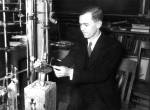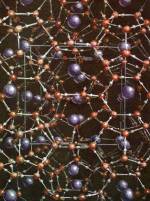|
Rather, almost everything Pauling did turned out well. One daring prediction Pauling
made based on his scale was that fluorine, estimated to be extremely electronegative,
would be able to form compounds even with an inert gas like xenon. Inert gases of
any sort were thought incapable of chemical combination, and the creation of a xenon
compound would have made history.
Experiments were needed to test his prediction. Pure xenon gas was extremely rare,
but Pauling managed to obtain a little of it from a colleague and gave it to his colleague
Don Yost, who worked through the summer of 1933 searching for the predicted compounds.
He could not find any — a failure that Pauling found both confusing and galling. The
reasons for Yost's inability to find what he was looking for are uncertain. But it
turned out that Pauling was right. Thirty years later, another team would make international
news by producing the xenon compounds Pauling had said were possible.
|
|
Click images to enlarge

Don Yost, approx. 1930.

Pastel drawing of Xenon Hydrate. 1964.
"I should like to do some work (with Professor Yost) in an attempt to prepare certain
compounds of xenon suggested by theoretical arguments. No doubt your xenon is precious;
if, however, you could lend us 10 cc or so (of not necessarily pure stuff), we would
try to return it to you either as such or in some compound (I hope), and we would
be properly grateful."
|

